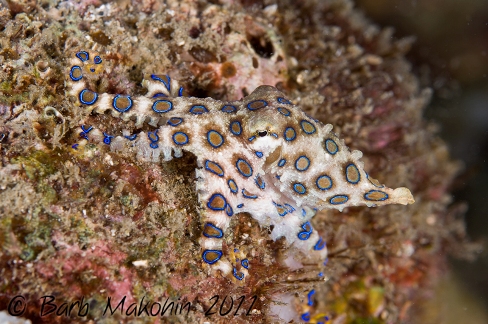Form and Function
Hapalochlaena lunulata are bottom dwellers that inhabit sandy
shallow reefs, clumps of algae, and tide pools at depths of
0-66ft (Aquarium of the Pacific). They have adapted to their environment by staying in
shallow depths because they are able to find their prey
easier (Aquarium
of the Pacific).
They have distinct blue circle rings that cover their skin, and
the center of each ring is usually a dark brown color (World
Database of Marine Species). They are
a deep brown to gold at rest allowing them to blend in with
their surrounding environment until they are disturbed (MarineBio). Each of
these rings contains chromatophores, which are pigment cells
that it can expand and contract by muscular action, that causes color change when
the animal is stressed (Animal
Diversity Web). They flash their trademark bright
iridescent blue rings that often seem to glow as a warning
response to perceived danger (Blue Ringed Octopus Facts). This
species of octopus has lost its ability to ink due to their ink
sac becoming smaller and smaller over evolutionary time (Aquarium
of the Pacific). They
don’t have many predators, but if provoked they have adapted to
the predators threats by having bright blue rings that signal to
the predator that the octopus is poisonous or venomous, instead of the
natural instinct of most octopus species to ink their predator
and swim away (The
Living World of Molluscs).
rings that cover their skin, and
the center of each ring is usually a dark brown color (World
Database of Marine Species). They are
a deep brown to gold at rest allowing them to blend in with
their surrounding environment until they are disturbed (MarineBio). Each of
these rings contains chromatophores, which are pigment cells
that it can expand and contract by muscular action, that causes color change when
the animal is stressed (Animal
Diversity Web). They flash their trademark bright
iridescent blue rings that often seem to glow as a warning
response to perceived danger (Blue Ringed Octopus Facts). This
species of octopus has lost its ability to ink due to their ink
sac becoming smaller and smaller over evolutionary time (Aquarium
of the Pacific). They
don’t have many predators, but if provoked they have adapted to
the predators threats by having bright blue rings that signal to
the predator that the octopus is poisonous or venomous, instead of the
natural instinct of most octopus species to ink their predator
and swim away (The
Living World of Molluscs).
All Cephalopoda in general have adapted to their environment by
having a soft body that can fit into any small spaces, including
one as small as a pinhole (Encyclopedia of Life).
They use this to hide from predators, and to search for
prey in hard to reach places. They have adapted to their environment by
using their muscular
tentacles to search for prey (The
Living World of Molluscs). Their tentacles are long allowing them to stick them into hard to reach places, and inside of
their prey’s body cavity (The Living
World of Molluscs). This adaptation is important to the
octopus because if it lacked muscular tentacles, it
would make it difficult to search and disarticulate their prey (The Living World of Molluscs).
Octopus have eight arms or tentacles but they do not use
them for swimming. The H. lunulata can dart quickly through the water to
catch prey or to escape from predators. Octopus swim by taking water up through their
body, and pushing a jet of water out of a tube called a
funnel which propels it forward (Experts123).They
have this unique body shape for navigating through the
water in elegant motions. The harder the octopus pushes
out the water the faster it can move (Experts123).
reach places. They have adapted to their environment by
using their muscular
tentacles to search for prey (The
Living World of Molluscs). Their tentacles are long allowing them to stick them into hard to reach places, and inside of
their prey’s body cavity (The Living
World of Molluscs). This adaptation is important to the
octopus because if it lacked muscular tentacles, it
would make it difficult to search and disarticulate their prey (The Living World of Molluscs).
Octopus have eight arms or tentacles but they do not use
them for swimming. The H. lunulata can dart quickly through the water to
catch prey or to escape from predators. Octopus swim by taking water up through their
body, and pushing a jet of water out of a tube called a
funnel which propels it forward (Experts123).They
have this unique body shape for navigating through the
water in elegant motions. The harder the octopus pushes
out the water the faster it can move (Experts123).
To learn about the nutrition of this species, go to the next page.
